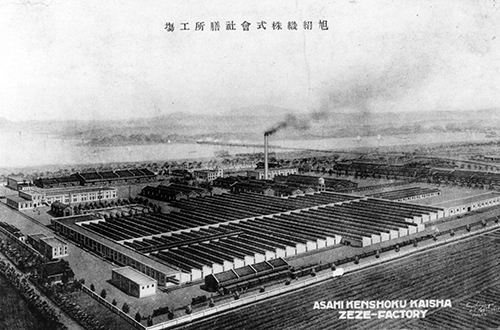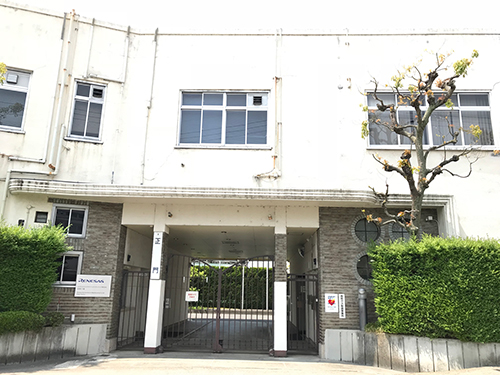100 Stories1922 Asahi Fabric Zeze Plant, the Root of the Company Name
The plant in the area that can be said to be the root of the Asahi Kasei name was closed before the 100th anniversary of Asahi Kasei. It was located in present-day Otsu City, Shiga Prefecture, and is now a semiconductor manufacturing plant of a subsidiary of Renesas Electronics.
In the late Meiji period (1868–1912), artificial silk (rayon) was imported from overseas as a substitute for silk, and because of its potential, Asahi Rayon was established in 1919 by merchants, including Itochu and Marubeni, from Omi Province (modern day Shiga Prefecture). Around the same time, Shitagau Noguchi, founder of Asahi Kasei, also envisioned the commercialization of rayon when he went to Europe to implement ammonia synthesis technology.
After Noguchi succeeded in negotiating a technical partnership with the German company Glanzstoff, he established a new company with Matazo Kita, president of Asahi Rayon, and decided to take over the Zeze plant of Asahi Rayon.
This was the birth of Asahi Fabric, which is said to be the foundation of Asahi Kasei. The year was 1922.
The ‘Asahi’ in Asahi Kasei is derived from Asahi Fabric. There is a temple called Gichuji Temple in Zeze (Otsu City, Shiga Prefecture) on the shores of Lake Biwa. There is the tomb and hall of Asahi General Kiso Yoshinaka at this temple, and the name ‘Asahi’ was taken to show a connection to Zeze.
The Zeze factory, which played a major role in Asahi Kasei's name, had access to water from Lake Biwa, and was also blessed with the ability to transport imported machinery and raw materials from the port of Kobe and products to high-demand areas in Kyoto, as well as the Hokuriku and Tokai regions. Most of the incomplete machinery and equipment from the Asahi Rayon era was scrapped, and state-of-the-art rayon-specific equipment was brought in from Germany.
Recruitment of workers proceeded smoothly, and operations began in 1924, the second anniversary of the company's founding. In the late Taisho Period (1912–1926), Asahi Fabric became a large factory employing approximately 1,000 workers. Demand was strong, and although the initial imported facility had a daily capacity of 1 ton, construction began on a second expansion with the same capacity. The second expansion was completed in 1926, but the company did not wait long before deciding to expand for the third time.
The third expansion was completed in 1927. The site of the Zeze plant was filled up at this point, and it was decided to build a branch plant in the Nobeoka area, where the Nippon Chisso Hiryo plant was located, for the next expansion. Around 1930, the number of employees at the Zeze plant grew to 2,500, and although the company experienced a recession, profits increased rapidly starting in the latter half of 1932.
In 1933, the company merged with Japan Bemberg Fiber and Nobeoka Ammonia Fiber, so Asahi Fabric was dissolved and became a division of Asahi Bemberg Fiber. Subsequently, the company was severely affected by the outbreak of the World War Ⅱ and decided to withdraw from the rayon staple business in the early 1940s. At the end of the war in 1943, the Zeze Plant was transferred to the former Sumitomo Telecommunications and became a plant for manufacturing vacuum tubes and other military equipment.
The plant was then transformed from a vacuum tube to a semiconductor plant and continued to operate, but at the end of August 2021, one year before Asahi Kasei's 100th anniversary, the last remaining compound production line was shut down and the decision was made to close the plant. The land for the plant was acquired for redevelopment by a real estate company in Osaka City.
 Re-selection work (from “Illustrated Chemical Industry,” ca.1928)
Re-selection work (from “Illustrated Chemical Industry,” ca.1928)
 Asahi Fabric, Zeze factory (1926)
Asahi Fabric, Zeze factory (1926)
 Building left as they were then (photo taken in 2019)
Building left as they were then (photo taken in 2019)

